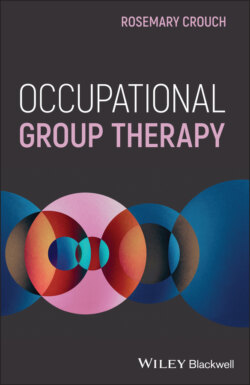Читать книгу Occupational Group Therapy - Rosemary Crouch - Страница 9
Introduction
ОглавлениеOccupational therapists are experts in the use of occupation as both a means and an end to facilitating health, and promoting participation in meaningful life roles. Occupation thus forms an integral part of occupational therapy group work in all areas of occupational therapy practice. (OTASA 2014)
This book is specifically aimed at encouraging students and qualified occupational therapists who are using group work in their programmes to move to a higher and more dynamic level of therapeutic intervention, particularly in the use of occupation in their groups. For example, techniques such as assertiveness training and stress management can be mundane ordinary groups with the occupational therapist handing out notes at the end, or they can be experiential, meaningful, active techniques which have lasting effects on clients. Examples of these effects may be the ability to communicate more effectively or to develop interpersonal relationships, to relieve anxiety or even bring about changes in behaviour.
Working at a higher level of therapeutic intervention does not always require postgraduate training, but attending workshops and established professional groups can be very helpful in gaining confidence and skill. Not many of these opportunities are available and therefore this book is designed to possibly partly fill this gap, and encourage occupational therapists to employ a deeper level of working with groups and feel more confident about it.
Ideas and techniques are presented in each chapter, which lift the leadership and the group process to a higher level of intervention. Every occupational therapist interested in group work has the potential, backed up by their training, to use and develop their skills creatively and make a difference in their clients' lives. In this book the author is encouraging group leaders using this book to get involved in effective ‘therapy’ and design group experiences for their clients which will allow them to work on themselves.
This book does not address the dynamics of group work separately as they should have been entrenched in the study of group work at an undergraduate level. Dynamics are however woven into the techniques described.
It is also important to note that the author has not included material on groups with children. It is however recommended that the reader refer to the book ‘Occupational Therapy in Psychiatry and Mental Health’ Fifth Edition, Edited by Rosemary Crouch and Vivyan Alers in 2014 and published by Wiley and Blackwell in London.
In Part three of this book there are excellent chapters which refer to group work with children. The chapter ‘Interdisciplinary Group Therapy with Children’ by Marita Rademeyer and Diedre Niehaus is particularly recommended.
The author would like to acknowledge a significant contribution to this book by a very revered colleague and friend, Louise Fouché who has made a real change to the way occupational therapists in South Africa think and practise their profession as regards occupational group therapy. Her contribution to the training of occupational therapy students and graduates has been significant. She has also contributed to the statements made by the Occupational Therapy Association of South Africa (OTASA).
It should be noted that some of the concepts discussed by Louise as part of her specific model of group work, the Occupational Therapy Interactive Group Model (OTIGM) will be discussed again in various contexts in other chapters. The purpose is to consolidate the reader's understanding of the concepts within different occupational therapy interventions.
The author would also like to mention Dr Enos Romano who has also generously shared his research in occupational group therapy with the author for inclusion in the research chapter of this book. It is very valuable and highly recommended for occupational therapists to read his published articles in the journals as referenced.
The first section of the book deals with the theoretical underpinning of occupational group therapy, and the second part gives practical advice on certain well‐used group techniques in the profession of occupational therapy. It is hoped that the addendums will be widely used by occupational group therapists in the field. The author acknowledges that Appendix A is colloquial in nature as the stress programmes that were specifically developed for an African rural environment. It is hoped that the reader can change them to suit the environment in which she/he is working. The actual programmes have been proved to be sound by scientific research.
